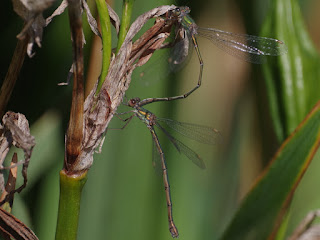A Great Spotted Woodpecker called near the Albert Memorial and could be seen at the top of a tree.
The latest Great Crested Grebe chicks could be seen at a distance on the Long Water. There are three of them. It's the second brood of this pair, which already have two grown-up offspring this year.
One of them tried to climb up its parent's back.
The other two chicks on the Long Water are aleady quite large, and at their noisiest. They came over to the near edge of the Vista when Ahmet was there, and he got two dramatic shots of a parent catching a perch ...
... and a chick swallowing it.
A female Mandarin came up to the shore, shining with subdued colours in the sunlight.
A female Tufted Duck dived in the shallow water in front of the Peter Pan statue.
The Gadwalls in the Italian fountain browsed on the algae which a warm day had brought up to the surface.
A Black-Headed Gull picked a tangle of algae off its legs.
Another did its best to swallow an Italian bread stick which some idiot had given it. Even when soaked in water this rock-hard thing was inedible, and the gull left it.
It was a good day for dragonflies and damselflies in the Italian Garden.
A male Migrant Hawker dragonfly basked in the sunshine on an iris leaf.
He cleaned one of his large eyes with a front leg.
A male Common Darter preferred the stone kerb of a fountain pool.
There was also a female laying eggs, which this species deposits in flight just under the water surface, bobbing up and down and hard to photograph. I didn't get a picture, but I think David Element did and we may see it later.
Update: here it is.
Willow Emerald damselflies mated on a withered iris flower.
Just for completeness, there was a Common Blue, though it was too far away for a good picture of this little creature.














Always a curious sight to see a diving bird swimming under water. It is lucky for us that the waters are so transparent as to allow such a clear view of it! The female ducks propels herself quite like a Grebe would do.
ReplyDeleteI'm melting at the sight of the tiny chick trying to climb its patient parent's back.
Grebes are far faster under water than diving ducks, and it's almost impossible to film them travelling at full speed. This clip gives only a slight hint of their rocket-like performance in a straight line, when they can reach perhaps 25 km/h.
DeletePleased your Great-crested Grebes are having such a productive breeding season. Seems to be the same on the Pen Ponds in Richmond Park with several youngsters and a bird still on the nest. However on the more local Ruislip Lido only one youngster this year.
ReplyDeleteYou had a good day for Odonata.
At least 10 Great Crested Grebe chicks alive at present. The best for some time, though the record in recent years is 16, in 2004 if I remember right.
DeleteAll the dragonflies and damselflies were within 15 feet of each other on the southern edge of the southeast Italian Garden fountain pool. This is also the only place where we see Red-Eyed and Small Red-Eyed damselflies. For some reason, a magic spot.